Catalogue > List by artist
Browse the entire list of Rencontre Internationales artists since 2004. Use the alphabetical filter to refine your search. update in progress
Shadi Habib Allah
Catalogue : 2017Dag'aa | Experimental doc. | hdcam | color | 19:0 | Palestine | 2016
Shadi Habib Allah
Dag'aa
Experimental doc. | hdcam | color | 19:0 | Palestine | 2016
Palestinian contemporary artist and filmmaker Shadi Habib Allah takes us with him on an unlikely journey of discovery – at gunpoint across the Sinai Peninsula, led by Bedouins who will force us across an unmapped terrain whose only signposts are the small stories they tell about the stakes of living, dying, and moving through this mysterious space. Stories, itineraries, directions, and allegiances become as blurred as the status of the Bedouins themselves, who remain unrecognized non citizens of this no man’s land, through which Habib Allah is led – behind the lines of military checkpoints, off the political, economic, and historical grid, a place where these desert outliers quietly continue their lineage with the help of snakes…
Born in Jerusalem, Palestine in 1977, Shadi Habib Allah received a BFA from Bezalel Academy of Arts and Design in 2003 and an MFA from Columbia University in 2010. His practice ranges from film, sculpture and drawing to installation. While each projects defines its own terms based on research and physical engagement, a common thread is opening up suggestive modes of navigation across circulation networks of people, technologies, objects, images and economy to examine ideas of use and value and the structures that hold them in place. He was twice awarded 2nd Prize for the Young Artist Award from the A.M. Qattan Foundation, and has attended residencies at Cittadelarte, Fondazione Pistoletto in Biella, Italy and Gasworks in London, England. He was nominated for the Luma Award 2011 and was the 2012 recipient of the Louis Comfort Tiffany Award. Habib Allah was a part of the fall residency program at Delfina Foundation in London, in October 2016. Habib Allah’s work has been exhibited at the New Museum Triennial (2015); Art Statements, Art Basel 43 (2012); Palestine c/o Venice, Venice Biennale (2009); the Riwaq Biennale, Ramallah (2009); and In Focus, Tate Modern, London (2007), amongst others. His Films have screened at the International Film Festival Rotterdam, Courtisane Festival Belgium, the 40th Norwegian Film Festival and 32nd Hamburg International Short Film Festival. Recent exhibitions include:I can call this progress to halt, Los Angeles Contemporary Exhibitions (LACE), Los Angeles, CA (2017); Black Box Screenings O Solitude, Beursschouwburg, Brussels, Belgium (forthcoming 2017);Daga`a, Green Art Gallery, Dubai, UAE (2017); House of Commons, Portikus, Frankfurt/Main, Germany (2016),Biscuits and Green Sox Maaike, Reena Spaulings Fine Art, New York, USA (2016)Shadi Habib Allah: 30KG Shine, Rodeo, London, UK (2015) The Verdant, Hacienda, Zurich, Switzerland (2015); Artists Space on Randall Island, Frieze Art Fair, New York, USA (2014); Empire State curated by Norman Rosenthal & Alex Gartenfeld, Palazzo delle Esposizioni, Rome, Italy (2013) & Galerie Thaddaeus Ropac, Paris, France (2013); Frozen Lakes, Artists Space, New York, USA (2013);Nouvelles Vagues, curated by Jason Waite and Antonia Alampi, Palais de Tokyo, Paris, France (2013). Shadi Habib Allah lives and works in New York.
Laura Haby
Catalogue : 2013OURS | Video | hdv | black and white | 5:30 | France | 2012
Laura Haby
OURS
Video | hdv | black and white | 5:30 | France | 2012
Ours dévoile l?intimité d?un agent forestier, ses gestes, ses parcours quotidiens et la sérénité théâtrale inhérente.
Après avoir fait ses études aux Beaux-Arts de Montpellier et obtenu un diplôme National d?Art Plastiques, Laura Haby, née en France en 1988, s?installe à Lyon. La production artistique de Laura Haby se situe du coté de la vidéo et de la peinture, aborde des écritures liées aux lieux comme motifs de référence. Ses ?uvres mettent en joue les paysages, les hommes qui y circulent et toute la dimension émotionnelle qui y trouve racine. Son travail a déjà été présenté dans plusieurs festivals ainsi que dans des dispositifs relevant des arts plastiques.
Yang Ah Ham
Catalogue : 2013Invisible Clothes | Experimental fiction | hdv | color | 13:31 | Korea, South | 2008
Yang Ah Ham
Invisible Clothes
Experimental fiction | hdv | color | 13:31 | Korea, South | 2008
`Invisible Clothes` is a quasi-sci-fi film about the conversation between a scientist and a fashion stylist on invisible clothes, reflects upon one`s ego constituted by the gaze of others and the subject perceiving that ego. An abundance of metaphors and satire exposes the absurdity of contemporary society, which constantly produces human desire. "The Other holds a secret-the secret of what I am. He makes me be, and thereby he possesses me, and this possession is nothing other than the consciousness of possessing me. (...) the Other steals my being from me." - Jean-Paul Sartre
Yang Ah Ham lives and works in Amsterdam, Netherlands and Seoul, Korea. She has lived in different cities and deals with society and individuals` lives through this experience. Yang Ah Ham showed her continuous project, `Adjective Life in the Nonsense Factory` in ArtSonje Center, Seoul 2010 followed by `Transit Life` in Gumho Museum of Art, Seoul 2005 and `Dream...in Life` in Insa ArtSpace, Seoul 2004. Her works also has been exhibited in Art of Communication :Anri Sala, Yang Ah Ham, Philippe Parreno, Jorge Pardo,The National Museum of Contemporary Art, Seoul,2011; Gwangju Biennale, Gwangju 2010; Shanghai Biennale, Shanghai 2008; Busan Biennale, Busan 2006. She was awarded Arts Award of the Year, Arts council Korea 2005 and nominated for Hermes Art Prize, Hermes Foundation 2008. Her monograph was published in 2011 supported by Mondriaan Foundation. Currently she was involved in the artist initiative project,`be mobile in immobility`(DEPO, Istanbul 2011, Total Museum, Seoul 2011) as a co-organizer . She studied at; New York University, New York; Seoul National University, Seoul; and did the following Artist in Residence, Platform Garanti contemporary Art Center, Istanbul 2010; Rijksakademie van Beeldende Kunsten, Amsterdam 2006-7; ISCP, The International Studio and Curatorial Program, New York 2003; ArtPace, San Antonio, U.S. 2000.
Robert Hamilton
Catalogue : 2006Shopping street | Experimental video | dv | color | 4:0 | Canada | 2004
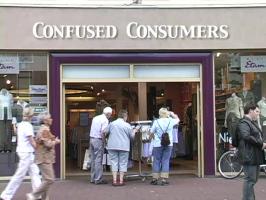
Robert Hamilton
Shopping street
Experimental video | dv | color | 4:0 | Canada | 2004
The title of the video Velserbroek is taken from the name of a neighbourhood outside of Haarlem, The Netherlands. The neighbourhood is an example of what is referred to in the Netherlands as "Social Architecture." It is a massive housing complex similar in many ways to a typical American suburb. However, the scale in which the Dutch housing divisions are built is significantly different. Currently there are complexes being built that contain over 8,000 residences. The complexes are also referred to as "VINEX" complexes. While visiting Velserbroek, the artist was struck by the near absence of people. It was nearly empty. It seemed that documenting the emptiness of what was projected as "Social Architecture" could be ironic. He took the idea one step further by digitally erasing all traces of cars, bikes and people from the video. Hamilton enhanced the emptiness and other-worldliness. He created the video with a consumer digital still camera resulting in a sort of time-lapse motion photography. The video is actually hundreds of still images edited together. The video is an exploration of the familiarity of "home" in a slightly surreal manner. Hamilton chose the subject of new houses in Holland as a metaphor for the sense of alienation and displacement of the traditional idea of home; familiar yet foreign. (Robert Hamilton)
Hamilton is a multimedia artist whose mediums include video, sound and sculpture. His video work began in 1983 and his videos have played in numerous national and international festivals, receiving many awards. Hamiliton's work leans towards experimental narratives exploring various kinds of human relationships. He invents interesting visuals and sound from the most modest of means.
Halloubi Hamza
Catalogue : 2012Leave | Video | dv | black and white | 3:45 | Belgium, Morocco | 2010
Halloubi Hamza
Leave
Video | dv | black and white | 3:45 | Belgium, Morocco | 2010
The spectator of the video is in the place of the one who is looking at a portrait of a close relative go away in the road. The spectator is put in the position of someone who leaves and sees things disappear / appear around him. The video ?Leave? is a search for the simplicity of a plan. The simplicity of a sensation.
Born in 1982 in Tangier, Morocco, Hamza Halloubi works across a wide range of media, including video, photography, sculpture, and installation. Exploring the relationship between the individual and the faculty of knowledge, he aims at a representation of alternative ideas of identity and culture by disrupting the dogmas of what is defined and established in culture. He comprises quotes in order to discuss issues such as institution, exile, solitude, and melancholy. Instead of direct perspectives he is interested in gestures and attitudes that upset the established order. Halloubi attended LA CAMBRE Ecole Nationale Supérieure des Arts Visuels de Bruxelles. He was the subject of a solo exhibition at The Monty "Modest Expectations", Antwerp(2011). Recent important group exhibitions include IMAGINE BEING HERE NOW The 6th Momentum Biennial, Moss, Norway(2011), FotoTageTrier 2010 ?LEBEN elementar?, Trier, Germany(2010), 4th Cairo Video Festival, Goethe Institute, Egypt(2010), BAD MOON RISING 3, Boots Contemporary Art Space, St. Louis, MO, USA (2010), the 1st International Roaming Biennial of Tehran 1st station: Istanbul, Turkey(2008) The artist lives and works in Brussels, Gent and Tangier.
Markus Hanakam, Roswitha Schuller
Catalogue : 2022The Moist Cabinet | Video | 4k | color | 5:8 | Austria, Germany | 2021
Markus Hanakam, Roswitha Schuller
The Moist Cabinet
Video | 4k | color | 5:8 | Austria, Germany | 2021
THE MOIST CABINET is inspired by the literary genre of climate fiction. Through the voice-over of the film, we encounter poems by Bettina von Arnim and William Shakespeare, each in the original language. Hanakam & Schuller view these poems from the 16th and 19th centuries a prequel to cli-fi. Both poets seem to be in dialogue with each other, yet testify to different attitudes: in Shakespeare, the description of nature serves as a catalyst of sexual desire; in Arnim, the physical encounter with nature triggers a need to preserve the source of erotic experience: “Your silence, nature, do not break.?/?Not on rustling leaf?/?With stylus wake thee.” THE MOIST CABINET thus also describes the influence of literary narratives on the relationships between nature and humans, and the consequential actions.
HANAKAM & SCHULLER is an artist duo living in Vienna. As artists and explorers, Markus Hanakam and Roswitha Schuller redesign the rules of fine arts and create unconventional arrangements and new world designs in videos and objects as well as applied artforms. Their works have been shown in Haus der Kulturen der Welt, Berlin; Eyebeam Art + Technology Center, New York; Palais de Tokyo, Paris; MAK, Vienna; MAK Center for Art and Architecture, Los Angeles; and the National Art Center in Tokyo. In 2022 they will work with Current Interests on a spatial installation for MAK Garage Top in Los Angeles.
Michelle Handelman
Catalogue : 2021These Unruly and Ungovernable Selves | Experimental video | 4k | color | 6:0 | USA | 2020
Michelle Handelman
These Unruly and Ungovernable Selves
Experimental video | 4k | color | 6:0 | USA | 2020
Michelle Handelman’s new video piece, THESE UNRULY AND UNGOVERNABLE SELVES (The Lockdown), recontextualizes characters from her previous works into a hypnotic visual essay about the transfiguring of interiority during periods of isolation and fear. It takes as its starting point the coronavirus pandemic and filters it through theorist Jill Casid’s writings on the necrocene, and Walter Benjamin's writings from The Arcade’s Project, sliding between threshold and boundaries, considering how bioterrorism may not only be an intentional release of viruses, but it may also be what lives inside, our own fear that late stage capitalism uses to destroy us. Handelman's characters, who each have already struggled with existential questions of belonging and fear in her projects DORIAN, A CINEMATIC PERFUME (2009/11); IRMA VEP, THE LAST BREATH (2013/15); and HUSTLERS & EMPIRES (2018), are juxtaposed with found images and texts sourced during the pandemic to take on a new form that both denies and struggles with containment. Casid writes, “May none of us rest as we live our dying. May we not forget but actually do the work of reckoning with the still uncounted, of the crimes of the endless war we are still in.”
Michelle Handelman is a visual artist, filmmaker, and writer whose work pushes against the boundaries of gender, race and sexuality. Coming up through the years of the AIDS crisis and Culture Wars, Handelman has built a body of work that investigates the dark and uncomfortable spaces of queer identity. She is a Creative Capital awardee (2019); Guggenheim Fellow (2011); Art Matters Awardee (2011) and NYFA Fellow (2011). She has exhibited widely including the San Francisco Museum of Modern Art, Eli & Edythe Broad Art Museum, PERFORMA Biennial, MIT List Visual Arts Center, PARTICIPANT, INC, The Henry Art Gallery; Museum of Contemporary Art Chicago, Contemporary Arts Museum Houston, Guangzhou 53 Art Museum; Film at Lincoln Center, The British Film Institute, and Centre Georges Pompidou. During the 1990s, Handelman was based in San Francisco where she collaborated with Monte Cazazza, a pioneer of the Industrial music scene; directed the feature film BloodSisters: Leather, Dykes and Sadomasochism (1995), and performed in several films by Lynn Hershman-Leeson. Her work has been written about in Bomb Magazine, Artforum, Art in America, Filmmaker Magazine, and The New York Times, and is in many private collections including the Eli & Edythe Broad Art Museum; Kadist Art Foundation, Paris; di Rosa Foundation and Preserve; Zabludowicz Art Trust. She is based in Brooklyn and is a Professor in the Film, Media and Performing Arts department at Fashion Institute of Technology, NYC.
Hangover Ltd
Catalogue : 2006Remake | Fiction | dv | color | 19:20 | Germany | 2004

Hangover Ltd
Remake
Fiction | dv | color | 19:20 | Germany | 2004
This film was inspired by John Cassavetes'"Faces", but something quite original takes place. The question "what do you expect from life?" is represented and performed with undisguised pleasure and with courageous risk-taking. In a quite tiny room, four women with different personalities and sexual expectations meet and walk around a handsome sailor. The result is an atmospheric and condensed miniature that oscillates between hysteria and self-mockery. Remake was awarded with the Prize for the Best Contribution to the German Competition in Oberhausen.
Hangover Ltd. is a group of young women who all are filmmakers and whose members are: Christine Groß, Sophie Huber, Ute Schall, Tatjana Turanskyj, and Claudia Splitt. They have been working together for a few years. They made PETRA which is a co-production with the Volksbühne am Rosa-Luxemburg-Platz, and "Sehnsucht nach Schüssen," with the Prater-Volksbühne among others.
Michael Hanna
Catalogue : 2015three short films about learning | Video | hdv | color and b&w | 8:57 | Ireland | 2014
Michael Hanna
three short films about learning
Video | hdv | color and b&w | 8:57 | Ireland | 2014
The Belfast Exposed photography archive contains over half a million images produced by community groups, amateur and professional photographers over the past 30 years. It represents a valuable historical document recording political, cultural and social change in Northern Ireland over these 3 decades. Since 2001 Belfast Exposed have been commissioning artists to produce work using this archive as raw material, previous artists include Duncan Campbell and Broomberg & Oliver Chanarin. Three Short Films about Learning is a latest project to be commissioned in this series. The work juxtaposes a selection of images taken from the archive with excerpts from a lecture series outlining theories of social and environmental psychology. The lecture series is Introduction to Psychology by Paul Bloom, made available by Yale University through the free online learning platform Academic Earth. The archive imagery includes marches, masked gunmen at funerals, and paramilitary punishments. The rhythm of the speech varies throughout from carefully measured statements to free flowing thoughts, and the images are timed to mirror this rhythm.
Michael Hanna completed his MFA at the University of Ulster in 2012 and recently undertook residencies at the Millennium Court Arts Centre and Digital Art Studios, Belfast. He graduated with BA (Hons) in Sculpture at Edinburgh College of Art in 2009. Hanna was shortlisted for the Converse / Dazed Emerging Artist Award with the Whitechapel Gallery, London. He has been involved in exhibitions in the UK and internationally including Interplanetary Revolutions at Golden Thread Gallery, Belfast and Instances of Agreement at the Kao Yuan Arts Centre in Taiwan. Most recently Hanna took part in Multiplicity - an exhibition curated by NURTUREart and shown across four galleries in New York. It was an international survey of artworks sharing an interest in the politics and poetic potential of contemporary urban environments.
Mike Hannon
Catalogue : 2017An Illustrated Guide to Lighthouse Spotting | Experimental doc. | 0 | black and white | 27:47 | Ireland | 2016
Mike Hannon
An Illustrated Guide to Lighthouse Spotting
Experimental doc. | 0 | black and white | 27:47 | Ireland | 2016
Framing the activities of a group of lighthouse spotters against the uncertain future faced by Irish lighthouses, An Illustrated Guide to Lighthouse Spotting idles with common documentary conventions in a kind of epistemological dilettantism, whereby the diseased triumvirate of rhetorical development, drama and realism is inoculated by mild incoherence, mundanity and idiosyncratic fancy.
Mike Hannon works as an independent artist, and as a freelance documentor for creative sectors and the visual arts. His previous pieces have included both conventional, TV documentary and experimental work.
Vincent Hannwacker, Mara Pollak, Marie Jaksch, Dominik Bais, Julian Rabus
Catalogue : 2022Musarion | Fiction | 4k | color | 29:39 | Germany | 2020
Vincent Hannwacker, Mara Pollak, Marie Jaksch, Dominik Bais, Julian Rabus
Musarion
Fiction | 4k | color | 29:39 | Germany | 2020
Musarion adapts the eponymous work by German writer Christoph Martin Wieland and transfers the love story into the present day. Phanias withdrew from the city of Athens to the countryside to leave his old life behind. But one day he encounters his former girlfriend Musarion who tries to bring him back to reason. The art film follows their struggle to find an enlightened form of love that can overcome philosophical and political fanaticism. Musarion was directed by a collective of five young artists and mixes elements of the original text, opera, theatre, video art and narrative film.
Vincent Hannwacker was born in 1997 in Munich, Germany. Since 2016 he studies Media Art at Julian Rosefeldt's class at the Academy of Fine Arts Munich. Since 2017 he studies Screenwriting at the University of Television and Film Munich (HFF).
Julieta Hanono
Catalogue : 2014Circunvalación | | | | 8:44 | France | 0
Julieta Hanono
Circunvalación
| | | 8:44 | France | 0
"Circunvalasion" fait partie de un working in progres - Barrio Godoy -que je commençais il y a deux ans. Un ensembles de travaux auteurs de la périphérie. Circunvalasion est le nom de une autoroute que entoure Rosario, una ville a 300k de Buenos Aires, en Argentina. Il y a des usines métallurgiques, le port est a quelques kilometres. Les camions viennent des diferentes provinces du pays. Av. circunvalacion 8,54 ?Film Numérique Dans la périphérie à Rosario, sur la Nationale A008 les camions passent sans interruptions. Marga et Mariela nous parlent au bord de la route.
Au commencement des années 70, adolescente engagée au côté des montoneros, Julieta Hanono est enlevée et incarcérée par la dictature argentine. Après un effacement de près de trois décennies durant lesquelles son expérience de la disparition semble s?être prolongée, cet épisode aura une influence profonde sur son travail. Au commencement des années 2000, installée en France depuis les années 80, Julieta Hanono renoue avec la pratique artistique, à laquelle elle avait dû brutalement renoncer. Ses pièces, teintée de psychanalyse et de marxisme, associant sculpture, dessin et film, sont traversées par son expérience de la disparition et se présentent comme une répétition de ses souvenirs, une conceptualisation méditative qui tend à la réconcilier avec son passé. Simultanément, les pièces se tournent vers l?extériorité : un mouvement qui correspond au souci de l?artiste de reconstituer son lien à l?autre et d?explorer, à travers celui-ci, les fondements de la socialité.
Catalogue : 2010En me tirant par les bras | Video | betaSP | color and b&w | 2:4 | France, Argentina | 2009
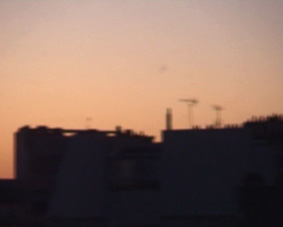
Julieta Hanono
En me tirant par les bras
Video | betaSP | color and b&w | 2:4 | France, Argentina | 2009
Catalogue : 2010Le bout des arbres | Video | dv | color | 2:12 | France, Argentina | 2009
Julieta Hanono
Le bout des arbres
Video | dv | color | 2:12 | France, Argentina | 2009
S?installer en France a d?abord signifié pour Julieta Hanono prendre de la distance avec sa langue maternelle. Puis revivre l?exil de ses arrières grands parents, d?Alep, d?Alexandrie, de l?Espagne à l?Argentine. Julieta Hanono souhaite redessiner leur parcours, elle parcourt Buenos Aires, puis arrive en France. A son arrivée à Paris, elle entreprend des ?uvres à partir de portes et de planches, des objets jetés, qu`elle récupère. Elle comprend plus tard le lien avec sa propre histoire : le 11 novembre 1977, à l?âge de seize ans, durant la dictature militaire en Argentine elle fût portée disparue. A Paris surgissaient les reliefs d?un récit enfoui, celui de sa propre histoire qu?en Argentine elle ne pouvait voir. Sa ligne d?horizon s?épaississait et son cheminement la conduisait à construire de nouvelles séries de travaux : des « bijoux », des ?uvres photographiques élaborés à partir d?instruments médicaux et des images numériques.
Catalogue : 2009intime | Experimental video | dv | color | 2:11 | France | 2008
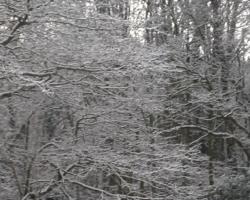
Julieta Hanono
intime
Experimental video | dv | color | 2:11 | France | 2008
Intimate is crossing of France from winter to summer from North to South. The sequences are enchained with her camera that flies almost without touching reality, as through deep in a dream: the lights and song of the night, cold haze of the dawn, the call of the animals, tears falling into space ending up in the desolation of the snow. ?Intimate? is also the idea that isolation develops on a journey through life till death. The artist wishes to be completely subjective when shooting. The film is in the first person and it can be seen as an homage to her father who disappeared and understanding that someone else?s life can be seen as a closed cycle only when that person is gone.
Coming to live in France first meant for Julieta Hanono that she was distanced from her mother tongue.Then to relive the exile of her great-grand parents, from Alep, Alexendria, went from Spain to Argentina. Julieta Hanono wanted to outline their journey, she went to Buenos Aries, then arrived in France. On her arrival in France she began her work with doors and planks of wood, things that were thrown out, which she retrieved. She understood later on, the link with her own history: on the 11th of November 1977, at the age of sixteen, during the military dictatorship in Argentina, she was reported missing. In Paris bits of her buried story began to emerge, her own story in Argentina which she wasn`t able to see. Her horizon expanded and her journey led her to construct a new series of work: "Jewels" is elaborate photographic work about medical instruments and digital images.
Catalogue : 2008El Pozo | Experimental video | dv | color | 5:30 | France, Spain | 2007
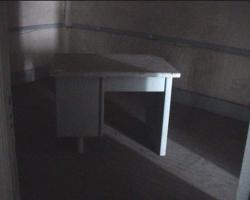
Julieta Hanono
El Pozo
Experimental video | dv | color | 5:30 | France, Spain | 2007
"Caméra au point, Julieta Hanono arpente le gouffre et s?avance jusqu?à la lisière de l?insondable territoire, celui où l?homme n?est plus l?homme. A l?image, des filets de lumière, des entrefilets de paroles, le tissage d?une pensée matière, épaisseur sans laquelle ne pourrait éclore un quelconque partageable. El Pozo, non lieu d?une histoire insensée ; « El Pozo », l??uvre de Julieta Hanono, « lieu-dit » constitué sur fond de ténèbres, masque rapporté sur une histoire demeurée hors du monde, sur une histoire sans visage. El Pozo n?existe pas, il est trou noir, anti-pensée comme l?on parlerait d?anti-matière. A l??uvre, nous ne le voyons pas. A l??uvre s?expose son exact envers, la raison reconquise. Le sujet doit s?exprimer sans ruser ; le Je doit prendre ici la parole. Je refuse de prétendre que quoi que ce soit du vécu de Julieta Hanono en tant que « disparue » puisse devenir pour moi compréhensible. Rien n?y fait, pas même cette ?uvre qui ne saurait rendre palpable l?inouï qui en est le creuset. Je refuse l?empathie qui semble être de rigueur ? de bienséance ? face à ce que d?aucuns nomment un « témoignage ». L?empathie ne peut être ici que feinte ; forme sommaire d?entente, elle demeure sourde au fond de l?histoire folle traversée par Julieta Hanono. L?inhumanité me restera inaccessible par la pensée, car elle en est son strict négatif. Ce que je vois, ce que je pense face à « El Pozo » est tout autre : il s?agit du chemin que parcourt Julieta Hanono pour renaître à la vie ; il s?agit du secret constitutif de « l?humanité de l?humain » dont parle Georg Lukacs. C?est précisément cette histoire que rapporte Julieta Hanono de son propre gouffre ; c?est précisément là que réside le partageable de son aventure. « El Pozo » expose, vive, l?histoire qui me constitue. « El Pozo » est le récit de la (re)conquête du sujet par lui-même, de la (re)naissance du Je. Voir « El Pozo » dans El Pozo éclaire d?un feu plus brûlant encore le secret dont cette ?uvre nous parle. Cette exposition boucle en quelque sorte la démonstration de vie. Placé (tout) contre les murs du gouffre, l??uvre affirme la conquête de l?artiste. Placé entre l?homme et l?espace de sa négation, l??uvre rend active de manière performative sa propre nécessité : elle recrée le sol même de la pensée en mettant à distance l?inhumain par les images et les mots. Jamais El Pozo n?aura été plus éloigné qu?au moment où « El Pozo » irradiera ces lieux ; jamais El Pozo n?aura été plus terrassé en tant que politique d?anéantissement que lorsque « El Pozo » s?y dressera. L??uvre de Julieta Hanono nous rend El Pozo habitable par la pensée, et sans doute rend-elle habitable par la pensée à l?artiste elle-même sa propre histoire insensée. ?uvre politique par excellence, « El Pozo » se comprend comme le récit de la lutte du sujet contre les machines qui dans l?histoire ont visé son éradication. Dans cette affaire ? constituer et entretenir le monde par les armes de la parole ? , l?artiste se situe en première ligne. Il est celui qui traverse les gouffres pour nous en donner l?image renversée, et donc habitable. Il est celui qui porte à bout de bras, à l?instar de Julieta Hanono arpentant El Pozo caméra au point, « l?humanité de l?humain » jusqu?à nous. Sébastien Thiery
Julieta Hanono Venir m?installer en France a d?abord signifié prendre de la distance avec ma langue maternelle. Traverser un autre idiome et réinventer à partir de ce détour mes propres mythes. C?est aussi revenir au point de départ, revivre l?exil de mes arrières grand parents, d?Alep, d?Alexandrie, de l?Espagne à l?Argentine. Et dans une spirale ascendante, je veux redessiner leurs parcours. Je pars de Buenos Aires et je débarque en France. A mon arrivée à Paris, j?ai entrepris des ?uvres à partir de portes et de planches que je récupérais. Je ramenais dans mon atelier des objets jetés ; après je compris que faire apparaître ce qu?étais disparus étais en relation a ma propre histoire : le 11 novembre 1977, à l?âge de seize ans, durant la dictature militaire en Argentine je fus portée disparue.( j?étais enlevée de la vie et jetée hors du monde) Ainsi, à Paris surgissaient les reliefs d?un récit enfoui, celui de ma propre histoire qu?en Argentine je ne pouvais voir. Trop proche, elle demeurait là-bas un point aveugle. Tunnel? Loupes / serrures. Ma ligne d?horizon s?épaississait et mon cheminement me conduisait à construire de nouvelles séries de travaux : des « bijoux » et des ?uvres photographiques élaborés à partir d?instruments médicaux. Notamment, je produisais des images numériques prises à travers un spéculum et constituais ainsi la série « Le tunnel ». Ambiguïté du spéculum réunissant en lui-même deux principes : loupe et serrure. Objet à double tranchant peut-être permettant de se rapprocher, de voir en vue d?un savoir scientifique et neutre ; mais aussi permettant d?épier, de se faire le voyeur d?une intimité secrète. « Le tunnel » se compose de différents tableaux. Il s?agit d?une série de déclinaisons, mais aussi d?instantanés que l?on peut approcher indépendamment de la série dans laquelle ils s?inscrivent. Images agrandies, avec une certaine pixellisation, ces « portraits féminins » de dimension identique varient néanmoins selon l?intensité de la lumière et de la couleur. La séquence se lit comme un kaléidoscope à travers lequel se scande le fond de l?affaire, l?énigme de l?origine démultipliée. Toutefois, en chacune de ces compositions l?intérieur ouvre sur ma propre ligne de fuite, mon propre passé noué à ce moment douloureux de l?Argentine, ces années de plomb de la dictature ; en chacune de ces compositions, un temps immobile, celui de mon propre enfermement, l?objet perdu.
Inger Lise Hansen
Catalogue : 2019Tåke | Experimental film | 16mm | color and b&w | 14:57 | Norway | 2018
Inger Lise Hansen
Tåke
Experimental film | 16mm | color and b&w | 14:57 | Norway | 2018
TÂKE is a landscape film capturing mysterious natural and man-made fog-obscured scenes in Beijing, Oslo, Azores and Newfoundland. The film observes the spectacle of fog through several different film- and video formats. It explores the behaviour of Super-8 and 16mm film alongside digital video against a visual obstacle. The variable formats are also used to create spatial shifts on the screen and work with ideas of obscured or filtered visions. Associations can be made between the grain in the film material and the tiny particles, or condensation nuclei, needed to form both fog and smog, such as pollen, sea salt, dust and particle pollution. In parallel to the image the soundtrack attempts to create an auditory fog. It compares the loss of visibility to the loss of audible frequencies. During the process of making the film the artist discovered that the way sound gets filtered in fog is similar to her own loss of hearing, where the high frequencies are no longer perceived. In the fog the tiny water droplets block the high frequencies from passing. The soundtrack is composed of sirens and signals, hearing tests samples and environmental sounds.
Inger Lise Hansen (b. 1963) is a visual artist with background in experimental film and animation. She studied Fine Art at University of East London (1989) and Central-St. Martin’s College of Art and Design (1991) and received a Master of Fine Art Filmmaking from San Francisco Art Institute in 1996. Since the nineties her film works has been screened in international institutions and galleries such as Tate Modern, National Gallery London, RI at Jeu de Paume Paris, Tokyo Photographic Art Museum and Malmö Konsthall. She has received a number of prizes from film festivals including Vienna Independent Shorts, Videoex, Ann Arbor and Oberhausen. Inger Lise lives and works in Oslo.
Mette Hansen
Catalogue : 2007Twosome | Animation | dv | black and white | 4:8 | Sweden | 2004
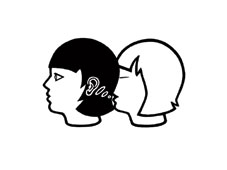
Mette Hansen
Twosome
Animation | dv | black and white | 4:8 | Sweden | 2004
The meeting of two people and a growing relationship is very seldom an uncomplicated matter. When dealing with the twosome aspect in this particular storyline, the focus is set on communication, dependence, trust, and integrity. It is a challenge to keep a balance between one and the other.
Artist Mette Hansen started of as a painter in the beginning of 1990. His studies of art caused him to be interested in different media and he started working with room installations and other sculptural objects besides photo. He eventually started to work with video and has doing so ever since. His first videos were about films that I studied and recut. Most recently he has only been using text and sometimes animated pictures in video.
Inger Lise Hansen
Catalogue : 2008Proximity | Experimental film | 35mm | color | 4:0 | Norway | 2006
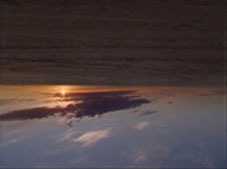
Inger Lise Hansen
Proximity
Experimental film | 35mm | color | 4:0 | Norway | 2006
An upside-down time-lapse camera is moved frame by frame on a track along a beach inverting the ground and the sky. The camera moves through four shots recorded in different weather conditions. The result is a mysterious and disorienting space in accelerated time, where the originally solid ground at the top of the frame appears to be sliding past like a lava-stream. Proximity was shot on Super16mm film, on location in North Jutland, Denmark.
Inger Lise Hansen was educated at North East London Polytechnic, St. Martin's College of Art, London, and received a Masters of Fine Art Filmmaking from San Francisco Art Institute. She has made a number of experimental animation films with support from Arts Council England, Film London, and the Norwegian Film Institute, and has won several international prizes such as Gold Prize for animation at the Bilbao Festival of Documentary and Short Films, and the Chris Frayne Award for Best Animation at Ann Arbor International Film Festival. Her earlier films have been screened at Tate Modern, London; Institute of Contemporary Art, London; Centre Georges Pompidou, Paris; Museum of Modern Art, Stockholm; and Hiroshima Animation Festival.
Hapaxmedia.net, colectivo ZEMOS98
Farheen Haq
Matti Harju
Catalogue : 2020Elä naura rakasta | Experimental doc. | hdv | color | 7:10 | Finland | 2019
Matti Harju
Elä naura rakasta
Experimental doc. | hdv | color | 7:10 | Finland | 2019
Connections, directions and boundaries blurred and reorganized. Bitten cake, flames, vodafone, compression, concrete and unassuming round shapes.
Matti Harju (b. 1978, Finland) has screened at the Rotterdam, Locarno, Torino, BFI London, Edinburgh, AFI FEST Los Angeles and Clermont-Ferrand festivals and elsewhere. He studied at National Film and Television School, UK and Academy of Fine Arts in Finland.
Catalogue : 2017New Age | Video | hdv | color | 9:58 | Finland | 2016
Matti Harju
New Age
Video | hdv | color | 9:58 | Finland | 2016
Speculative video essay about accelerationist pastel hues and semi-paranoid trademarks at the time when everything is nearing the end of the World.
Matti HARJU (b. 1978, Finland) is working in the rubbish bin of contemporary art including video, narrative cinema, text, drawing, installation, life as a jpeg performance. He has screened work at the International Film Festival Rotterdam, Festival del film Locarno, Torino Film Festival, BFI London Film Festival, Edinburgh International Film Festival, AFI FEST Los Angeles and Clermont- Ferrand International Short Film Festival among others. Solo exhibitions include Gallery Sinne (collaboration with Joakim Pusenius) in March 2015 and Exhibition Laboratory Project Room in February 2016, both in Helsinki. Currently an MFA candidate at the Academy of Fine Arts, FI. He also studied film directing (MA in Directing Fiction) at the National Film and Television School, UK.
Catalogue : 2016Tomorrow was Magnificent | Experimental fiction | 4k | color | 15:25 | Finland | 2015
Matti Harju, Joakim Pusenius
Tomorrow was Magnificent
Experimental fiction | 4k | color | 15:25 | Finland | 2015
We hear the past like a sentimental echo from times when we came together, the future like an answer to our needs, and the present like a silence in which we alone are standing still. Tomorrow was Magnificent was born out of this silence, as an end and a new beginning of nothing – apeiron.
Joakim Pusenius (b. 1984) graduated with an MFA from the Academy of Fine Arts in 2014. He also holds a BA in theoretical philosophy. Pusenius has exhibited in various galleries in Finland and his works have been shown at film screenings. Matti Harju (b. 1978) took his BA at the Institute of Design and Fine Arts in Lahti, studied at the National Film and Television School in the UK, and is now on the Master’s programme at the Academy of Fine Arts in Helsinki. His previous works have been shown at for example Rotterdam, Locarno, Edinburgh, BFI London and Torino film festivals.
Catalogue : 2012Afrikka | Experimental fiction | 16mm | color | 9:3 | Finland | 2011
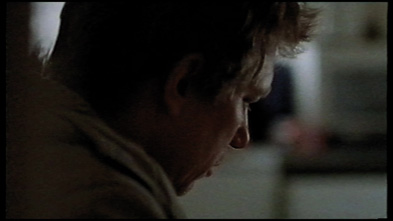
Matti Harju
Afrikka
Experimental fiction | 16mm | color | 9:3 | Finland | 2011
Glenn is in a state of acute psychosis.
Matti Harju (b. 1978, Finland) studied filmmaking at the National Film and Television School in the UK. His previous short films have been shown in numerous film festivals around the world including Clermont-Ferrand, Locarno, Rotterdam and Edinburgh.
Matti Harju
Catalogue : 2023Ekstaasi | Experimental fiction | mov | color | 9:48 | Finland | 2022
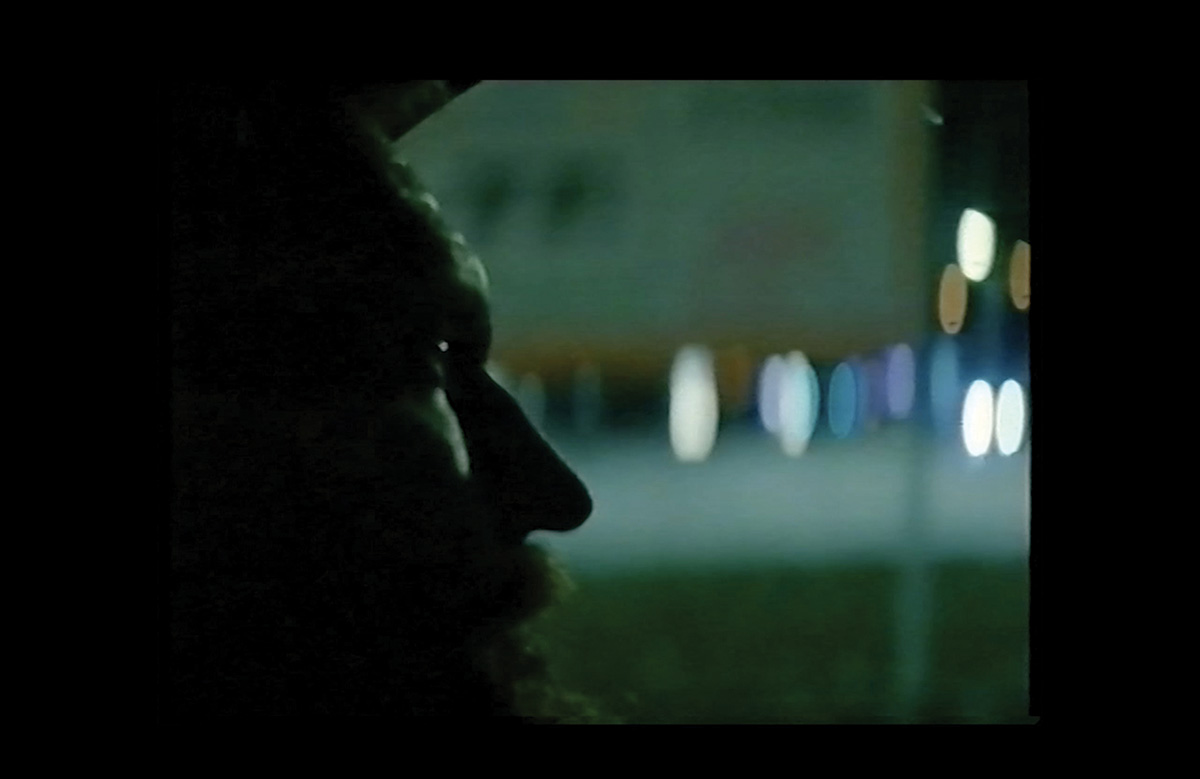
Matti Harju
Ekstaasi
Experimental fiction | mov | color | 9:48 | Finland | 2022
Set in the darkest time of the year, a feverish and delirious film about a small and ever-shrinking island – the Ecstasy – located somewhere between the search for pleasure and the inherently destructive powers of capitalism.?
Matti Harju has screened work at the Rotterdam, Locarno, Kurzfilmtage Oberhausen, Torino, BFI London, Edinburgh, AFI FEST Los Angeles and Clermont-Ferrand film festivals among others. He studied film directing at the National Film and Television School (NFTS) in the UK and holds an MFA from the Finnish Academy of Fine Arts. His second feature, Fury, is currently in post-production.
Catalogue : 2022Kolme päivää sadetta | Experimental fiction | mov | color | 14:3 | Finland | 2021
Matti Harju
Kolme päivää sadetta
Experimental fiction | mov | color | 14:3 | Finland | 2021
Part time Twitch streamer, part time drug courier; both low level. Slithering between life and death, online and offline. The carefree summer of global progress seems to be over - are these the final days of both, the illusion of overarching narrative, and of Jerome the Saint.
Matti Harju has screened work at the Rotterdam, Locarno, Oberhausen, Torino, BFI London, Edinburgh, AFI FEST Los Angeles and Clermont-Ferrand film festivals among others. He studied film directing at the National Film and Television School (NFTS) in the UK and holds an MFA from the Finnish Academy of Fine Arts.
Matti Harju, Joakim Pusenius
Catalogue : 2020Elä naura rakasta | Experimental doc. | hdv | color | 7:10 | Finland | 2019
Matti Harju
Elä naura rakasta
Experimental doc. | hdv | color | 7:10 | Finland | 2019
Connections, directions and boundaries blurred and reorganized. Bitten cake, flames, vodafone, compression, concrete and unassuming round shapes.
Matti Harju (b. 1978, Finland) has screened at the Rotterdam, Locarno, Torino, BFI London, Edinburgh, AFI FEST Los Angeles and Clermont-Ferrand festivals and elsewhere. He studied at National Film and Television School, UK and Academy of Fine Arts in Finland.
Catalogue : 2017New Age | Video | hdv | color | 9:58 | Finland | 2016
Matti Harju
New Age
Video | hdv | color | 9:58 | Finland | 2016
Speculative video essay about accelerationist pastel hues and semi-paranoid trademarks at the time when everything is nearing the end of the World.
Matti HARJU (b. 1978, Finland) is working in the rubbish bin of contemporary art including video, narrative cinema, text, drawing, installation, life as a jpeg performance. He has screened work at the International Film Festival Rotterdam, Festival del film Locarno, Torino Film Festival, BFI London Film Festival, Edinburgh International Film Festival, AFI FEST Los Angeles and Clermont- Ferrand International Short Film Festival among others. Solo exhibitions include Gallery Sinne (collaboration with Joakim Pusenius) in March 2015 and Exhibition Laboratory Project Room in February 2016, both in Helsinki. Currently an MFA candidate at the Academy of Fine Arts, FI. He also studied film directing (MA in Directing Fiction) at the National Film and Television School, UK.
Catalogue : 2016Tomorrow was Magnificent | Experimental fiction | 4k | color | 15:25 | Finland | 2015
Matti Harju, Joakim Pusenius
Tomorrow was Magnificent
Experimental fiction | 4k | color | 15:25 | Finland | 2015
We hear the past like a sentimental echo from times when we came together, the future like an answer to our needs, and the present like a silence in which we alone are standing still. Tomorrow was Magnificent was born out of this silence, as an end and a new beginning of nothing – apeiron.
Joakim Pusenius (b. 1984) graduated with an MFA from the Academy of Fine Arts in 2014. He also holds a BA in theoretical philosophy. Pusenius has exhibited in various galleries in Finland and his works have been shown at film screenings. Matti Harju (b. 1978) took his BA at the Institute of Design and Fine Arts in Lahti, studied at the National Film and Television School in the UK, and is now on the Master’s programme at the Academy of Fine Arts in Helsinki. His previous works have been shown at for example Rotterdam, Locarno, Edinburgh, BFI London and Torino film festivals.
Catalogue : 2012Afrikka | Experimental fiction | 16mm | color | 9:3 | Finland | 2011

Matti Harju
Afrikka
Experimental fiction | 16mm | color | 9:3 | Finland | 2011
Glenn is in a state of acute psychosis.
Matti Harju (b. 1978, Finland) studied filmmaking at the National Film and Television School in the UK. His previous short films have been shown in numerous film festivals around the world including Clermont-Ferrand, Locarno, Rotterdam and Edinburgh.
Sabrina Harri